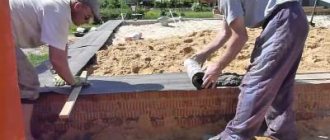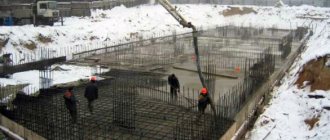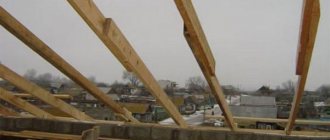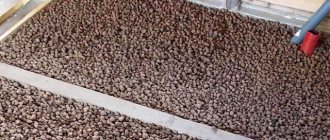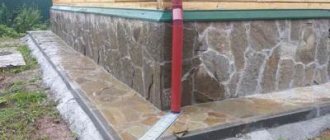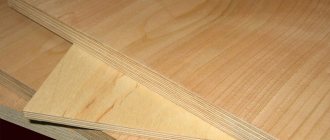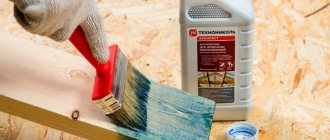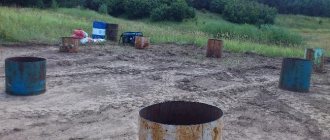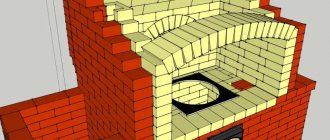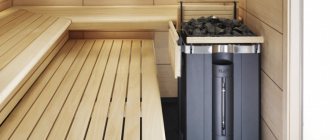In the construction of a brick house or other facility, half-brick brickwork is most often used, which is suitable for the construction of internal partitions, but does not allow the construction of load-bearing walls with a thickness of ≤ 380 mm in accordance with SNiP II-22-81 regulations. The document determines that the minimum thickness of load-bearing walls for group I brickwork is limited to the range of 4% -5% of the height of the house or floor. If the height of the house does not exceed 5 meters, then the load-bearing structure must be at least 250 mm thick, that is, one brick. The thickness of the half-brick masonry is 120 mm, which is not enough to withstand the weight of the house. Therefore, in order to save materials in regions with a warm climate, builders resort to a trick: a load-bearing wall of half a brick is laid out with perpendicular dressing, which, taking into account the thickness of the mortar layer of 8-10 mm, makes it possible to achieve standards for the thickness of the load-bearing wall of 250 mm.
Such a wall can easily withstand the load from the weight of a low-rise building, and the internal walls and partitions are raised with ordinary half-brick masonry with a wall thickness of 120 mm. Such a wall does not take the main loads, but can easily withstand the weight of decorative items, furniture and household appliances. In addition, laying bricks according to this scheme is much stronger than plasterboard or wooden partitions, and using only bricks and mortar saves the family budget, since bricks and mortar are consumed 2 times less than when laying bricks, one and a half or two bricks , and undoubted savings in comparison with the consumption of materials for partitions made from other building materials.
How to lay a half-brick wall
The sand must be clean - river or sifted.
Cement for laying half bricks must be used at least grade M 500. All bricks must be saturated with water, placing them in a tank and completely filling them. The time spent in the water is at least an hour. A wet brick will not absorb moisture from the mortar, which will allow the cement to set evenly, providing the design strength of the wall. Beginning of installation: the corner supports are removed first. The second row is laid on the first brick row, and the process continues until the top row after the reinforcing mesh frame. Corner masonry has a height of 5 bricks, laid in such a way that the guide brick overlaps (ties) each other at an angle of 900. Each row must be checked for verticality and horizontality using a level. Bricks are pressed into the mortar only in the center of the product to prevent movement to the sides.
After laying the bricks up to the first layer of armored belt, a cord is pulled along the first row to control the laying. The mortar is applied in an even layer over the entire row and the bricks are laid. After the third row, the evenness of the wall is checked. After laying each subsequent row, the cord is raised to the height of the brick. To ensure the required strength, after the fifth row it is recommended to take a two to three hour break in work to allow the solution to set. To build a wall faster, it is allowed to use high-strength double brick M 150, which has dimensions: 120 x 138 x 250 mm.
Since double bricks are large in size, it makes sense to give the masonry greater strength by using more frequent mesh reinforcement. There are ready-made meshes on sale with a rectangular or zigzag profile, but you can make a stack with your own hands. The rectangular reinforced mesh should be laid horizontally every five rows. A mesh with a zigzag profile is laid in the attached places of the masonry, its rods are connected by welding or knitting with wire. When carrying out reinforcement, the mesh is laid so that the ends of the rods protrude 5 mm beyond the wall. This is necessary to control the presence of reinforcement. After the solution has hardened, these protruding ends can be cut off or bent.
Nuances of construction
During the construction of masonry, reinforcement is required. Start it after the third row and apply it after every fifth. For reinforcement, anchors, metal mesh, and steel rods are used.
To prevent fresh masonry from accidentally deforming, the construction of a ½ brick partition is carried out in stages, four to five rows, after which a break is taken so that the masonry mixture can set.
Special attention is paid to the laying of corner sections, if any. By violating the verticality and turning degree, you will “fill up” the corner, after which certain problems will arise related to the construction of the wall or the installation of door and window blocks.
To avoid this, the laying of corners after every second row is controlled with a building level and a square. Reinforcement of such areas is carried out perpendicularly with laid mesh strips with an overlap of seven to eight centimeters, or with metal rods curved at the required angle and placed ten centimeters on the adjacent edge.
Crossing steel bars directly at a corner is not allowed.
A few words should be said about the dressing of the seams and their thickness.
The next row begins with a stone shifted by half the size. Vertical and horizontal seams of masonry partitions made of ½ brick should be the same in thickness - from six to eight millimeters, therefore, in the process of preparing the masonry mortar, it is necessary to sift all components to prevent large fragments from entering the mixture, which can increase the thickness of the seam.
To eliminate void areas in the seams, the mortar is applied to the brick edge, the stone is pressed tightly against the already laid element, and leveled in place by gently tapping it with a trowel handle or a mallet. Excess solution squeezed out from under the stone is removed.
A wall half a brick thick implies special attention to the arrangement of opening areas, if any are determined by the design specifications. For their ceilings, lintels are prepared, the length of which is thirty centimeters greater than the opening width, so that each end rests on the wall with a fifteen-centimeter end. The height of the lintel is determined based on two values of the thickness of the masonry building material.
If there is no factory-made jumper, it can be successfully replaced with a pair of metal corners that are suitable in length. They are installed on masonry mortar at an angle inward to the opening; brick material is laid on metal shelves. This method is used if you plan to decorate the wall, allowing you to hide the corners under the cladding layer.
In the event that the brickwork is not planned to be finished with plaster mortar or other facing material, it is recommended to use a special tool to joint the joint areas. This measure will allow you to remove excess masonry mortar and give the surface an aesthetic appeal.
Jointing is carried out during masonry work, almost after each laid row, until the mortar mixture has had time to set. If this moment is missed, you will have to moisturize the suture areas.
Laying fence posts: technologies
In most cases, fence posts are made of 1.5 or 2 bricks, the cross-section is 380*380 mm and 510*510 mm, respectively, and the height is up to 3 meters.
The masonry is carried out with bandaging (offset) - the seam of the bottom row is overlapped by the “body” of the brick lying on top. The standard seam is 8-10 mm. The diagram for laying columns of one and a half and two bricks is in the photo below.
Brick pillars of 1.5 and 2 bricks
Laying pillars: work order
Cut-off waterproofing is spread on the finished foundation. It can be roofing material in two layers, but it is better to use waterproofing with bitumen mastic. This layer is necessary so that the brick does not “pull” moisture from the soil. If wet brick freezes, it will quickly begin to crack and crumble. Therefore, waterproofing is necessary. Rolled waterproofing can be replaced - coat the foundation twice with bitumen mastic, and in areas with high humidity it is better to do double waterproofing - coat it with mastic, and then lay “Gidroizol” as well.
According to the size of the pillar, a layer of mortar a little more than 1 cm is applied to the waterproofing. Bricks are laid on it, according to the diagram. They are leveled in vertical and horizontal planes by tapping with a special rubber hammer. Craftsmen can use the handle of a trowel, but in this case, the remains of the mortar can fly off the surface of the trowel, staining their hands and the brick, and it is difficult to wipe off the cement.
Ceramic brick absorbs moisture very quickly, so if you hesitate a little, it will be difficult for you to “put” it in place. To ensure that the solution retains its plasticity longer, the brick is dipped in water for a few seconds before laying. The same maneuver makes it easier to wipe the solution from the surface (it is removed immediately with a dry cloth).
We hit with a hammer
The second row is laid in the same way: the mortar is spread on the bricks, the bricks are placed on it, but with a bandage - unfolded so that the seam is blocked. Level again. Then take a tape measure and check the dimensions of the laid rows. Even a small displacement of 1-2 mm is eliminated. Tap the end of the brick (called a “poke”), moving the bricks closer. Then, if the side edges were not coated, fill the vertical seams. All subsequent rows are placed similarly.
If there is a void between the inner reinforcement pipe and the brickwork, it is filled. If the distance is small, you can use masonry mortar; if the void is significant, to save space you can fill it with crushed stone, compact it, then pour it with liquid cement-sand mortar.
Masonry under the rod
The masonry of pillars described above has long been tested, but for beginners, when making it themselves, it is difficult to maintain an even seam. Another problem is that the solution comes out of the seam, staining the surface. It doesn't turn out very nice. To make the work easier, we came up with a laying under the rod. Take a square metal rod with a side of 8-10 mm, cut it into pieces, 10-15 cm longer than the dimensions of the post.
Bar layout
Having laid the first row, a rod is laid on it along the edge of the brick. Fill the area with a small amount of solution, with a larger layer being made closer to the pipe. Then, running a trowel along the rod, remove the excess, clearing the rod of the solution. But at the same time, the slope of the solution is maintained. They place a brick and level it. At the same time, the rod prevents it from settling too much, and we control the position of the other end with a level.
Apply the solution to the side edge under the rod
Then take a short piece of rod about 10 cm (for a vertical seam), place it along the butt, apply the mortar with a trowel to the side of the laid brick, also removing the excess along the rod. The second brick is placed and leveled. After the level is set, the seam is pressed from above with a trowel, and the vertical rod is removed.
We take out the rod, holding the seam with a trowel
This is how all the bricks are laid out in a row. Then the rods are removed and proceed to the next row. This technology for laying brick pillars allows you to control the seams and make them neat. Even a novice amateur mason can fold a pillar this way with his own hands.
It is only important to control the parameters of each row during the process (so that the column in the cross-section is the same size)
Stages of work
The general layout of half-brick masonry is as follows:
- if it is planned to divide the internal space into separate zones with a partition, it is necessary to arrange a strip foundation;
- The partition is tied to load-bearing walls using anchors, one end of which is monolithic in the masonry joint, the other is installed in the masonry of the load-bearing wall;
- if the height of the partition does not exceed 280 cm, and the length varies between 475 - 500 cm, the masonry rows are not reinforced. But if it is planned to install hanging elements, a metal mesh is laid after every fourth row.
Preparation
Before laying a brick, certain measures are performed:
- in the place where masonry work is expected to be carried out, the coating (if any) is removed and debris is removed;
- the floor surface is leveled;
- marking is carried out;
- the base on which the masonry is planned is moistened;
- The mortar mixture is prepared.
Calculating the first row
Imagine that the foundation for masonry is ready. To lay the first row, you should not rush, so as not to redo everything later.
The initial row is laid out without masonry mortar, observing the thickness of the vertical seam, which is eight millimeters.
This will determine how many stones you need and whether you will need to trim the material.
Laying the first and second rows
We begin the construction of half-brick brickwork with our own hands.
First, the highest corner section is determined, a brick is laid on the mortar, and adjusted to the location using a building level. In a similar way, the brick is installed on the opposite corner. Once all sections have been completed, a marking cord is pulled along the beacons.
Layout of the first row begins.
The second line of brick stone is laid in such a way that the middle of each brick overlaps the vertical seam located below.
Description, application
Often, when building simple structures that will not bear serious mechanical loads, people try to save money. Therefore, during construction work, cheap building materials (for example, drywall) are often used, which do not always have the necessary characteristics. A good solution for the construction of simple structures would be to build half-brick brickwork. At the same time, in the case of indoor construction, the floor does not require reinforcement - its strength is often sufficient to withstand the mass of half-brick masonry.
This type of masonry first appeared around 7000 BC. Archaeologists have discovered objects that belong to the ancient Indian culture in India and Pakistan.
Over the past time, masonry technology has remained virtually unchanged. It is carried out in such a way that the visible part will consist only of the tray parts of the brick. The laying principle is quite simple - the bricks are laid one row at a time on a layer of mortar. In this case, the masonry is carried out in a checkerboard pattern so that the vertical seams between the rows of bricks do not form one line. Failure to comply with this rule leads to deterioration in the strength of the structure. This masonry provides a wall thickness of 12 cm - the width of the brick (if there is no additional wall finishing). This thickness allows you to withstand the weight of hanging furniture, but will not be able to withstand the weight of the building structure. Therefore, such masonry cannot be carried out for the construction of load-bearing walls (after all, according to SNiP and the Construction Law, the thickness of load-bearing walls should not be less than 38 cm).
Basic tools for half-brick masonry.
Any structures (for example, roof rafters) can be supported on such walls only after an examination and a special permit (project) has been issued from the regulatory services. In this case, the load on such a wall should be limited - it can withstand a weight of about 120-130 kg. Therefore, you need to hang furniture and equipment on it based on these figures (for example, you cannot hang a 150-liter electric water heater on such a wall). In the case of the construction of walls, one side of which is outside the building, additional strengthening (reinforcement) of the masonry structure is necessary. To do this, the reinforcement is laid so that it forms a transverse “lattice”. The reinforcing grid is fastened by welding to the backfill elements in adjacent walls. The lattice pitch is 3-4 bricks (rows) thick. The reinforcement can be supplemented with metal mesh, which is placed in the seam.
You can build such walls for the following purposes:
For fencing beds. This type of masonry is especially often used for fencing flower beds on the street in front of the entrance to the yard. This will prevent accidental or intentional collisions with flower beds. For the construction of interior partitions. Such masonry will create a solid wall that will have good sound insulation, and will also allow finishing with any materials.
It is important to take into account the weight of the finish (for example, the total weight of the plaster) and not to overload the wall. Construction of auxiliary buildings. For example, dog kennels, small sheds, coal bunkers, etc.
When constructing such objects, it is strongly recommended to organize a foundation for masonry (more details will be discussed in the “preparatory work” section). Construction of various types of fences: to prevent soil sliding (if the site is on a slope), to visually separate any objects, etc. However, such masonry cannot be used when constructing full-fledged fences, since the wind load at a wall 1.5 meters high and more than 2 meters long exceeds 350 kg.
Read below about how to perform similar masonry for various needs and under various conditions.
Purpose
Half-brick brickwork is used for the construction of structures such as:
This type of masonry is used in the construction of non-load-bearing interior walls.
- Fences and enclosures taking into account the local specifics of winds and their load.
- Interior walls without load-bearing. Such partitions are better than those made of plasterboard in terms of strength and sound insulation. They are well suited for supporting cabinets, shelves and other furniture elements. As a basis for finishing work, it will withstand greater loads than wood or drywall.
- Outbuildings: storerooms, sheds, outdoor toilets, gazebos, verandas, etc.
- Flower beds, fences for gardens, restricting the movement of people and vehicles.
- Specialized restrictive structures, demarcation areas, preventing soil movement, regulating storm flows, etc.
Return to contents
Rules for preparing masonry mortar
For laying brick stone, a mortar made from sand and cement material is used. The sand must be clean, preferably river sand, without foreign impurities. The cement used is grade m 400.
Mixing is done manually or in a concrete mixer, but the sequence of steps does not change.
The sand is sifted, mixed with the binder until homogeneous, after which water is added. As a rule, its volume is 0.4 - 0.6 of the total amount of the batch, but it is best to supply the liquid in portions in order to monitor the plasticity index of the masonry mortar.
A plastic mixture is more convenient to work with than a rigid one, but for laying hollow brick stone its consumption increases, since the mixture gets into the voids. For this case, a hard mixture is considered more practical.
For ease of use, plasticity is increased by adding lime, clay, or a liquid detergent composition to the masonry mass. The volume of any of the additives should not exceed 0.1 part, but this is quite enough to significantly improve the characteristics of the masonry mortar. It becomes more manageable when styling and does not flake for a long time.
There is no need to immediately prepare a large volume of sand-cement mortar. It’s better to prepare a batch that you can easily work with in a couple of hours. And even this volume begins to create problems by the end of the control period - moisture separates and setting begins. This state of the mixture is influenced by weather conditions and the quality of the cement material. For those new to working with brick material, you should prepare very small batches, since the work of laying the stone will progress slowly.
Many people do not know at what temperature it is allowed to lay bricks. If you do not use special components in the solution, then you can work with the masonry mixture at a temperature of at least seven degrees Celsius. This is the standard limit at which normal setting of the solution occurs. A lower temperature practically stops the hardening process, the mortar begins to crumble, and the walls receive a low margin of safety. In such cases, it is recommended to add anti-frost additives to the masonry mass, but this will entail considerable financial costs.
Generally accepted standards
Nowadays there are many varieties of bricks. Each type has its own load. For example, along with solid bricks, today they use perforated bricks, which are also called effective. It retains heat better and is considered the most popular in low-rise construction.
When creating walls, you need to understand what thickness will be most acceptable. When making cladding, it is enough to lay out the wall in one brick. For a load-bearing brick wall and calculating its thickness, it is important to know to what level negative temperatures drop and what mode of heating of the premises is required.
It is convenient to use generally accepted calculations that have long been used in construction practice. To create walls, solid masonry with cold mortar is often used. Such a wall is usually plastered on the inside. If the average temperature does not drop below -10 degrees, a sufficient thickness is 380 mm. At lower temperatures (from -20 to -30), the thickness of the brick wall should be at least 640 mm. At -40 degrees it is better to make a wall 770 mm wide.
Types of masonry.
When efficient or multi-hole bricks are used for construction, the walls can be made thinner. For example, if the temperature drops from -40 to -48 degrees, a width of 640 mm will be sufficient.
Any brick can be used to create interior walls. However, here too the load must be taken into account. If it is high, experts do not recommend using the M75 brand of brick.
Laying fence posts: technologies
In most cases, fence posts are made of 1.5 or 2 bricks, the cross-section is 380*380 mm and 510*510 mm, respectively, and the height is up to 3 meters.
The masonry is carried out with bandaging (offset) - the seam of the bottom row is overlapped by the “body” of the brick lying on top. The standard seam is 8-10 mm. The diagram for laying columns of one and a half and two bricks is in the photo below.
Brick pillars of 1.5 and 2 bricks
Laying pillars: work order
Cut-off waterproofing is spread on the finished foundation. It can be roofing material in two layers, but it is better to use waterproofing with bitumen mastic. This layer is necessary so that the brick does not “pull” moisture from the soil. If wet brick freezes, it will quickly begin to crack and crumble. Therefore, waterproofing is necessary. Rolled waterproofing can be replaced - coat the foundation twice with bitumen mastic, and in areas with high humidity it is better to do double waterproofing - coat it with mastic, and then lay “Gidroizol” as well.
According to the size of the pillar, a layer of mortar a little more than 1 cm is applied to the waterproofing. Bricks are laid on it, according to the diagram. They are leveled in vertical and horizontal planes by tapping with a special rubber hammer. Craftsmen can use the handle of a trowel, but in this case, the remains of the mortar can fly off the surface of the trowel, staining their hands and the brick, and it is difficult to wipe off the cement.
Ceramic brick absorbs moisture very quickly, so if you hesitate a little, it will be difficult for you to “put” it in place. To ensure that the solution retains its plasticity longer, the brick is dipped in water for a few seconds before laying. The same maneuver makes it easier to wipe the solution from the surface (it is removed immediately with a dry cloth).
We hit with a hammer
The second row is laid in the same way: the mortar is spread on the bricks, the bricks are placed on it, but with a bandage - unfolded so that the seam is blocked. Level again. Then take a tape measure and check the dimensions of the laid rows. Even a small displacement of 1-2 mm is eliminated. Tap the end of the brick (called a “poke”), moving the bricks closer. Then, if the side edges were not coated, fill the vertical seams. All subsequent rows are placed similarly.
If there is a void between the inner reinforcement pipe and the brickwork, it is filled. If the distance is small, you can use masonry mortar; if the void is significant, to save space you can fill it with crushed stone, compact it, then pour it with liquid cement-sand mortar.
Masonry under the rod
The masonry of pillars described above has long been tested, but for beginners, when making it themselves, it is difficult to maintain an even seam. Another problem is that the solution comes out of the seam, staining the surface. It doesn't turn out very nice. To make the work easier, we came up with a laying under the rod. Take a square metal rod with a side of 8-10 mm, cut it into pieces, 10-15 cm longer than the dimensions of the post.
Bar layout
Having laid the first row, a rod is laid on it along the edge of the brick. Fill the area with a small amount of solution, with a larger layer being made closer to the pipe. Then, running a trowel along the rod, remove the excess, clearing the rod of the solution. But at the same time, the slope of the solution is maintained. They place a brick and level it. At the same time, the rod prevents it from settling too much, and we control the position of the other end with a level.
Apply the solution to the side edge under the rod
Then take a short piece of rod about 10 cm (for a vertical seam), place it along the butt, apply the mortar with a trowel to the side of the laid brick, also removing the excess along the rod. The second brick is placed and leveled. After the level is set, the seam is pressed from above with a trowel, and the vertical rod is removed.
We take out the rod, holding the seam with a trowel
This is how all the bricks are laid out in a row. Then the rods are removed and proceed to the next row. This technology for laying brick pillars allows you to control the seams and make them neat. Even a novice amateur mason can fold a pillar this way with his own hands.
It is only important to control the parameters of each row during the process (so that the column in the cross-section is the same size)
Video lessons
A more complex version of a brick pillar - twisted with a screw
Features of working with ceramic bricks
Recommendations from experts
To ensure that laying out the walls does not bring unnecessary expenses, a careful calculation should be made before purchasing the material. Brick should be taken with a reserve in case of a fight. By drawing a detailed plan for the location of each row and taking into account the dimensions of each part, you can most accurately determine the required amount of building material.
Before masonry, construction should be carried out without using mortar. Once again checking the correctness of the construction, you can connect the solution to the work. The bricks should be moistened before laying, so the composition will better adhere to their surface.
The basic rule for carrying out such work is no haste and careful measurements. During the process of laying masonry, its elements must be in close contact with the mortar. For better grip, you should tap them with a mallet or the handle of a trowel. The remaining solution is cleaned off and put back into the container. Gradually, in the process of constant interaction with this building material, the skill of working with it appears. Subsequent actions will be more confident and correct, the masonry will be smooth.
Standard masonry scheme of one and a half bricks
One of the widely used methods in the construction of buildings consisting of more than one floor is masonry with one and a half bricks, the scheme of which is widespread everywhere. This is due to the fact that such masonry increases the load-bearing capacity of the walls. Brick laid in this way looks beautiful and neat, and the appearance of the building is impressive even without additional processing. A wall laid using this method provides an excellent surface for the next stage of decorative finishing.
One of the most popular masonry methods is one and a half brick masonry.
Brick is a man-made stone that is used in construction everywhere. To create this material, all kinds of components are used to enhance one or another quality, depending on the requirements for the structure and the climatic zone where the construction takes place. Regardless of the composition, the standard dimensions of the material accepted throughout the world are as follows:
- length - 250 mm;
- width - 120 mm;
- height - 65 mm.
Articles on the topic
Foundation for a brick house - strip, monolithic, slab, instructions, advice from masons
Brick foundation - step-by-step instructions, pros, cons, instructions, advice from masons
Wooden floors in a brick house - types, how to install, instructions, advice from masons
Repair of the basement of a brick house - major, partial, instructions, advice from masons
Brick cornice - how the masonry is made, varieties, instructions, advice from masons
How to paint the outside of a brick house - types of paint, instructions, advice from masons
Cladding a house made of aerated concrete with bricks - masonry, disadvantages, instructions, advice from masons
Brick foundation for a wooden house - types, instructions, advice from masons
Reviews ()
Brick laying technique
There are three bricklaying technologies:
- Press it in.
- Suck it.
- Half-sucked.
Press-on technology
To perform this technique, you must be able to use a trowel or trowel well. This technology requires a hard solution. It is used for laying spoon and butt rows. With this type of masonry, all seams remain filled.
The “pressing” technology begins with applying the solution with a trowel. It needs to be smoothed out to make a flat bed. It is worth remembering that the cement-sand mixture is laid out at a distance of 1 or 1.5 cm from the edge of the wall.
Then, using the edge of the tool in the right hand, part of the mortar is raked up and pressed against the side edge of the previously laid brick. With the other hand, the next brick is placed in its place and after that the trowel is removed, leaving the vertical seam between the blocks filled with a cement-sand mixture.
After this, the position of the brick is leveled in all three planes. In order for the rows of the wall to be even, it is necessary to monitor the tension of the mooring cord. If, after seating the block, excess mortar appears in the horizontal or vertical seams, it must be cut off with one movement of the trowel and moved further along the wall to lay the next blocks.
Despite the complexity of such masonry, the seams remain completely filled, so the strength of this technology is very high.
Laying "butt" and "tuck"
Butt-butt technology
A more plastic solution is used here. Seam filling is not 100%. They are partially filled when laying subsequent rows. This type of wall construction is called emptying. This method is used for spoon and butt rows.
The process of laying bricks begins with spreading and leveling the bed several blocks ahead. Then, holding the brick at an angle, part of the spread material is captured by the butt edge. The mortar should be raked at a distance of up to 12 cm from the last laid brick. If bonded brickwork is performed, the mixture is raked with a spoon edge.
As the brick approaches its place, it must be leveled to a horizontal position. So, part of the mortar that was previously located on the bed ends up in the seam between the bricks.
Then the block is leveled on all planes and aligned with the mooring cord.
This method is easier because it allows you to use both hands to line up the blocks. If, when applying the mortar, you plan to trim it with a trowel, this method will take more time than brickwork without trimming. The “pressing” method is the most time-consuming, but it ensures complete filling of vertical seams.
When laying out the bed, remember that it should be located 2-3 cm from the edge of the wall. Thanks to this, when the brick moves along the bed in the direction of the previously laid one, the mixture will not protrude outward. This is especially true for facing masonry or when insulation of a brick wall is not planned.
Half-squat technology
This method is very similar to the one described above, but is most often performed for laying backfills. Such brickwork is carried out in the presence of two external, most often spoon rows. In the middle, where the backfill row is located, a mortar bed is laid out and leveled.
Layout diagram of 2.5 bricks
The movement of the brick along the mortar bed towards the previously laid one begins 6-8 cm. At this time, part of the mortar is captured by the spoon edge. The seam remains practically unfilled. When laying the next row, the mason needs to ensure that the required amount of cement-sand mixture gets into the joint and the seam is completely filled. If the joints between the blocks are poorly filled, the thermal insulation and strength characteristics of the wall are reduced.
When laying the backfill, it is necessary to accurately maintain the level and plane with the adjacent spoon rows. The interlocking brickwork should not protrude or be recessed.
Characteristics of a brick country house
Before building a country house, you need to decide how often the owners plan to stay there. If during a warm period, a small summer house is built. For permanent residence, you should think about a cottage. The basic requirements for setting up a country house are as follows:
- A small house requires a kitchen, a lounge and a terrace.
- Electricity must be supplied to the building.
- A mini-house, despite its size, must be capacious.
You can create housing on the site with your own hands. Using the Internet, it is easy to find a drawing or project you like, as well as photographs, estimates and calculations of how many bricks are needed for construction. There are a large number of interesting options that fit into a relatively small amount. Plots and houses with natural gas supply and distribution, autonomous sewerage, and automatic lawn watering should be designed and built by professionals.
Read also: How to treat house plants
Reinforcement methods
Brickwork can be strengthened in different ways:
- reinforcing mesh. It is produced in different widths; the thickness of the steel wire is three to five millimeters. This section is excellent for laying in a masonry joint without increasing its thickness. The mesh is easily cut into strips of the required sizes;
- roll mesh. The cell sizes and strip widths may vary, but the option is considered more economical than the previous one, since it allows you to cut elements to the required dimensions;
- polymer masonry mesh. It has certain advantages over its metal counterpart. It is lightweight, does not corrode, and has a low thermal conductivity, completely eliminating the formation of “cold bridges.” As soon as the masonry mortar hardens, the polymer mesh is firmly held in the seam, as if it were a steel gasket. The main advantage is flexibility, allowing installation in corner areas and vertical joints. True, a mesh made of polymer material will have to be laid more often than its metal counterpart;
- steel rods. Their cross-section should be three to six millimeters, installation is carried out in one or two rows in the middle of the brickwork to strengthen them vertically and horizontally. At the joints, wire overlaps must be at least fifteen sizes in diameter. Wire for reinforcement is produced in coils starting from two hundred kilograms;
- flexible connections. The reinforcing material used when making brickwork strengthens such a wall. In the case when facing work is carried out on a building in use, the brick wall must be connected to the main structure to prevent deformation and collapse. To do this, use flexible connections consisting of a steel or composite rod with a length of eighteen to thirty-five centimeters. The reinforcing end is fixed in the supporting structure, the second is laid in the mortar mixture of the brick row. The grip is improved by the notches or sand coating on the rod. Flexible ties will reliably connect the facing brick finish to the main structure without increasing the thickness of the masonry joints.
Necessary equipment
To successfully complete the work, you will have to carry out certain preparatory activities. You will need:
- concrete mixer;
- container for masonry mortar, buckets, shovels of various types;
- Master OK. They apply masonry mortar and remove its excess. It is recommended to use a tool with an angled or round blade;
- mallet or rubber mallet. Using such tools, brick stone is leveled horizontally and vertically. The soft impact parts of the tools do not cause any damage to the stone;
- mason's pick. With its help, the masonry material is split into elements of the required size. The blows are delivered with a sharp edge;
- marking cord for even laying of rows;
- square for controlling the turning degree;
- a plumb line with which to check the verticality of the masonry;
- building level, controlling the horizontality of the brick row;
- jointing With its help, smooth, concave or convex seams are made.
It is allowed to use various devices to help lay the mortar mixture or fix masonry joints.
Basic principles of the process
Brickwork technology is the key points that are considered common to the construction of any objects. The subtleties of the process may change when choosing one or another masonry method, but it is imperative to master the basic techniques.
First of all, it is important to decide on the type of foundation and the width of the masonry. The height is calculated using a special table, which contains information about the thickness of the brick, the corresponding thickness of the mortar and the number of blocks per 1 square meter. A foundation is required for any heavy building
For non-residential buildings of one floor, a columnar foundation is sufficient. It is better to install a reliable house on a strip or solid foundation. Brick is considered a heavy material, so it requires a strong base. The higher the number of floors of the house, the stronger the foundation should be
A foundation is required for any heavy building. For non-residential buildings of one floor, a columnar foundation is sufficient. It is better to install a reliable house on a strip or solid foundation. Brick is considered a heavy material, so it requires a strong base. The higher the number of floors of the house, the stronger the foundation should be.
The thickness of the masonry determines the thermal insulation and sound insulation qualities of the building, as well as its fireproof properties.
There are 5 types of masonry in thickness.
- Half a brick. The thickness is equal to the width of the bed - 12 cm. This option is suitable for non-residential one-story buildings.
- One brick. The thickness of the wall is equal to the length of the bed - 24–25 cm. Sufficient for a one-story house with thermal insulation.
- One and a half bricks. The thickness of the structure is formed by two rows of blocks. It is equal to 36–37 cm, respectively. Such masonry will be reliable for one-story and one-and-a-half-story buildings.
- Two bricks. This option consists of the length of two beds - 48–50 cm. You can safely build a two-story cottage on a solid foundation. The total weight and cost of such a building are quite high.
- Two and a half bricks. The thickness of the walls is 60–62 cm. Rarely used for multi-storey residential structures. In addition to the large weight, such a building will require investment in a heating system.
Having determined the required width and type of building material, you can begin to build the foundation and lay bricks. In the process, you need to follow the rules.
- Use devices to control horizontal and vertical lines to ensure that the masonry is level. The most important step is to lay out the first row correctly.
- The corners are built first, then the middle part of the wall. The corners serve as guides for laying out even horizontal rows.
- The direction of the row laying is from left to right.
- The blocks are placed on the mortar so that in horizontal rows the top brick rests on the two bottom ones. The support area is at least one quarter of each of the two lower blocks.
- The solution is placed on horizontal and vertical seams. This protects the brickwork from cracking.
- A mandatory element of masonry is dressing. It guarantees strength and protection against delamination.
- To further strengthen the building, metal reinforcement is used.
- Between the masonry and the foundation, waterproofing (roofing felt or mortar) is required.
- If the wall is planned to be plastered, the seams do not need to be filled completely. This way the plaster will adhere better.
- Facing and working bricks are laid out according to the same rules.
Types of masonry
There are several ways to lay a brick. The thickness of the wall or room partition will depend on this.
Brickwork is a structure made of bricks laid in a certain order and fastened together with mortar
Several techniques are traditionally used:
- quarter brick - the beam is installed horizontally with an axis along the wall, resting on the smaller side, while the width of the wall or partition will be minimal 65 or 88 mm, depending on the type of material;
- half a brick will provide a wall with a width of 120 mm, which is enough for summer buildings or as decoration for a cinder block wall;
- single brick masonry is used for external walls, it will be 250 mm;
- a wall width of one and a half bricks will provide better thermal insulation, as it is 340 mm;
- for a two-story building, we lay a wall at least 510 mm wide in two bricks.
Functional purpose
In order for the result of the work done to meet expectations, you must follow the rules:
- Partitions that are intended for zoning space should have a standard thickness of 14 cm. The necessary rigidity can be achieved by reinforcing the seams with metal reinforcement.
- Internal load-bearing structures should be 28 cm thick. This figure corresponds to the width of two bricks.
- If construction work is carried out in warm areas, a traditional approach is sufficient.
- In the northern regions, the accumulation and conservation of thermal energy in living rooms is the main task. The correct wall thickness is 66 cm. The laid foundation must be strengthened because the total weight of the structure increases significantly.
- For ordinary storage rooms and equipment rooms, the standard half-brick approach is sufficient, without the construction of large structures.
How to do it yourself?
A wall, plinth and any other structure can be made using brickwork of 1.5 bricks without the involvement of professionals. Of course, the result will largely depend on the quality of the work performed. It is necessary to rely on step-by-step instructions to achieve the desired result. Let's get acquainted with all the stages of such work using the example of making a wall of 1.5 bricks.
Preparatory stage
As with any other construction work, the manufacture of a brick structure according to the above scheme involves a number of preparatory steps. You will need to buy high-quality building materials and prepare a suitable binding solution for it. In addition, you will definitely need to purchase a number of tools and accessories:
- trowel (otherwise called a trowel);
- hammer;
- jointing;
- mopping;
- plumb line;
- level;
- square;
- cord;
- order;
- roulette;
- rule;
- pendulum.
Before proceeding with installation, you will need to familiarize yourself with a number of nuances (let's look at them using the example of wall construction):
the thickness of the specified masonry usually reaches 380 mm (this parameter is the sum of the width of one part, the width of the element attached to it and the thickness of the seam); you will need to pay special attention to the correct layout of each corner and bandaging of rows; for a sufficiently good dressing of 1.5 bricks, it is necessary to use full-size, half-size, and three-quarter products; You will first need to mark the location of row 1 (of course, after choosing the laying technology).
Dressing options
Typically, masters turn to the following types of dressings:
- single-row (or chain);
- multi-row.
Single-row dressing is considered simple. With it, they alternate between tie and spoon rows on the outside of the planned base (if it is a wall). In this case, large quantities of non-full-size bricks will be needed.
Multi-row dressing is done like this:
- the starting row is laid out “spoon-poke”;
- the second is the opposite;
- Rows 3,4,5,6 are laid out in spoons with a bunch of seams in half a brick.
Laying corners
Corners are the basis for the construction of brick structures such as walls. Even small flaws in the layout here can lead to a serious violation of the geometry. Because of this, the load-bearing capacity of the structure can be significantly reduced.
This is required so that it becomes possible to establish orders and to be able to stretch a special cord between them. It will help to monitor the evenness of the rows during the laying process. The technology of laying 1.5 bricks is more complicated when compared with the technique of 1 block. This is explained by the fact that in the first case it will be necessary to use building materials of various formats (meaning fours, three-quarters and halves).
Masonry work
First, you will need to waterproof the foundation by laying sheets of roofing felt on it. After this, using a building level, masonry is made in several rows in the corners of the future construction. Corner orders will then be attached to them using special brackets. You will need to stretch a special cord along the orders. It is recommended to place it every 5 m. If the length between the constructed corners is greater, then in order to avoid stretching the cord, a beacon made of bricks is placed in the middle. After this, it is possible to move on to arranging brick rows.
Using a trowel, lay out the prepared masonry composition. The step from the edge of the wall should be about 20 mm. If the seam begins to be filled entirely, then no more than 10-15 mm. The thickness of the layer should be maintained within 25-30 mm. Based on the consistency of the solution, you will get seams of 10-12 mm.
Masonry techniques
There are three types of masonry of 1.5 bricks. Let's get to know them.
- Press it in. This method of laying bricks is recommended if you are working with a solid binder. In this case, the seams are completely filled and jointed. The remaining mortar is moved to the vertical of the previously placed block with a trowel. Then they place the next brick that needs to be pressed against the trowel. The trowel must be pulled out sharply. The laid out part settles.
- Suck it. This method is relevant when working with a plastic composition. At the same time, the brick is slightly tilted, one of its faces touches the laid mortar, moves it towards the previously fixed part and sets it down.
- Butt with trimming. This technology differs from the above-mentioned only in that the binder must be laid at a small distance from the edge of the wall. The mortar protruding beyond the joints is then removed with a trowel.
A layout of 1.5 blocks can be done with insulation. It is simply attached to the load-bearing wall base and then covered with plaster.
What interior partitions will support hanging furniture and protect the room from noise?
The interior space of the house must be divided into zones fenced off from each other. For this purpose, stationary or transforming partitions are provided. Today we will talk about the construction of stationary partitions from the most popular materials
General requirements
As a rule, partitions are self-supporting structures supported by floors or other load-bearing elements of the building. First of all, they must have sufficient strength ,
to withstand loads from hanging furniture or equipment, which can sometimes be quite heavy (for example, the weight of plasma panels reaches 50 kg or more).
One of the functions of dividing walls in residential buildings is soundproofing :
according to SP 51.13330.2011 “Protection from noise”, their sound insulation index Rw should be 52 dB.
And if the air temperature in neighboring rooms differs by more than 10°C (as, for example, in a cold vestibule and hallway), then the partitions need to have heat-insulating properties.
An important point is fire safety: usually partitions are constructed from materials with a fire resistance limit of at least 0.25 hours. And finally, the last requirement is environmental friendliness and compliance with sanitary and hygienic standards.
Brick
Partitions made of ceramic bricks are durable, moisture resistant, and have good sound insulation and fire protection characteristics; when using appropriate fasteners, they are capable of bearing high loads from attached objects. And only a brick partition can withstand the weight of heavy cladding, for example, in the form of large slabs of natural marble.
In a country house, these structures are most often made of half a brick - solid or hollow (slotted). The first one is stronger, moreover, it is the only one suitable for use in wet areas - in bathrooms, kitchens, etc. However, masonry made from it will be very heavy: 1 m2 of a partition half a brick thick (120 mm) weighs about 250 kg (with taking into account the solution), and therefore it is necessary to calculate whether the ceiling will withstand such a load.
From this point of view, hollow brick is better, since it is lighter, but it will be problematic to install fasteners into it so that they securely hold massive hanging objects.
In addition to traditional bricks in the form of a bar, various figured (shaped) products are also produced, with the help of which you can complicate the plasticity of the masonry. Such partitions not only delimit rooms, but also serve interior design purposes.
A partition made of any material is installed on the ceiling even before applying a layer of screed, and a brick partition is no exception.
The brick is laid on a cement-sand mortar, forming a joint 10–15 mm thick. Every five to six rows, the masonry is reinforced along its entire length with metal rods Ø 4–6 mm or reinforcing mesh. The ends of the rods are fixed to the adjacent load-bearing wall, and the gap between it and the partition is sealed with polyurethane foam.
Whatever material the dividing wall is built from, if there is a doorway in it, the lintel above it must be strengthened.
In the case of a brick partition, a reinforced concrete beam is most often used for this.
Before finishing, the masonry needs to be plastered, and due to the inevitable unevenness of the base, it must be plastered in a thick layer (from 15 to 50 mm), which results in a considerable consumption of mortar. Thus, taking into account the weight of a brick partition, the labor intensity of its construction, the cost of the brick itself and other necessary materials, we can say that such structures are justified only when the requirements for their strength or soundproofing properties are very high. At the same time, it is worth keeping in mind that there are a large number of seams in the masonry, and if they are not carried out in good faith, gaps may appear, which will reduce the level of sound insulation. And a loosely filled joint between the partition and the load-bearing wall will become an excellent channel for transmitting noise from one room to another.
Aerated concrete blocks
Aerated concrete, made from mineral raw materials, is not inferior to natural materials in its environmental characteristics. It has a minimal level of radioactivity, does not emit toxic substances, does not burn, and is not damaged by mold and mildew. Due to its cellular structure, aerated concrete has high vapor permeability and absorbs sound well.
Expanded polystyrene
First, external cleaning of dirt and dust will be required, then they should be leveled, since otherwise there is still the possibility of a void occurring between the polystyrene foam board and the surface, which can cause deformation. The next step will be priming if you use glue when installing the insulation.
Next, the plate is glued using special glue or “fungi”. For greater reliability, you can use both options simultaneously. When insulating with extruded polystyrene foam, the surface for applying glue must be rough. And finally, everything is plastered or faced with brick.
Installation of expanded polystyrene using a frame made of slats is also used, if there is no further brick cladding or use of plaster. Slats thicker than the slab are attached to the wall, the distance between which should be optimal for a tight fit of the slabs.
External thermal insulation
From the outside, the wall is protected by thermal insulation material from cold air and dampness, and from the inside it is warmed by the heat of the room itself, which will also help it dry out if moisture suddenly accumulates. The dew point moves in the direction of the street, therefore, condensation also moves in this direction, as can be seen in the photo.
External insulation will help preserve the comfort and warmth of a half-brick house. We can conclude that there are quite good reasons not to resort to internal insulation of the house. This is only possible in desperate situations.
Read also: Beneficial insects for humans
